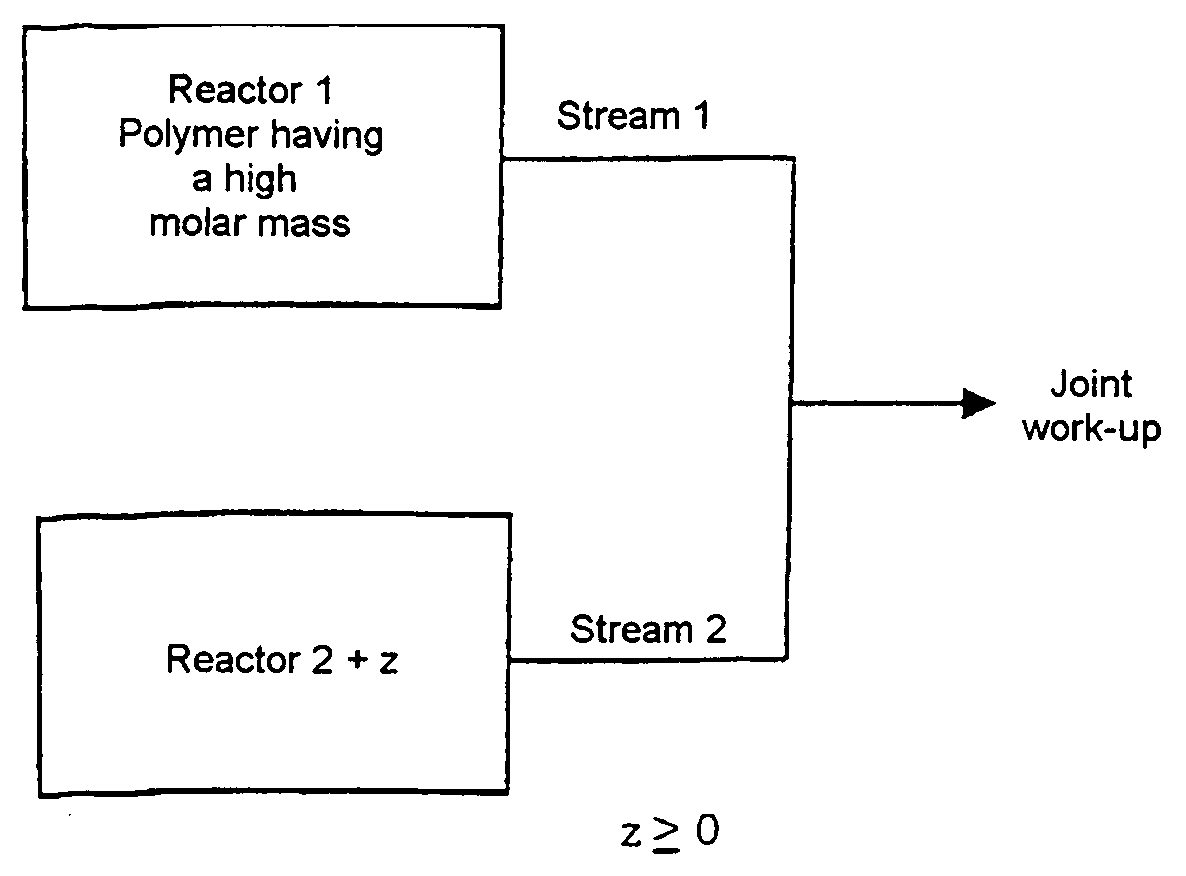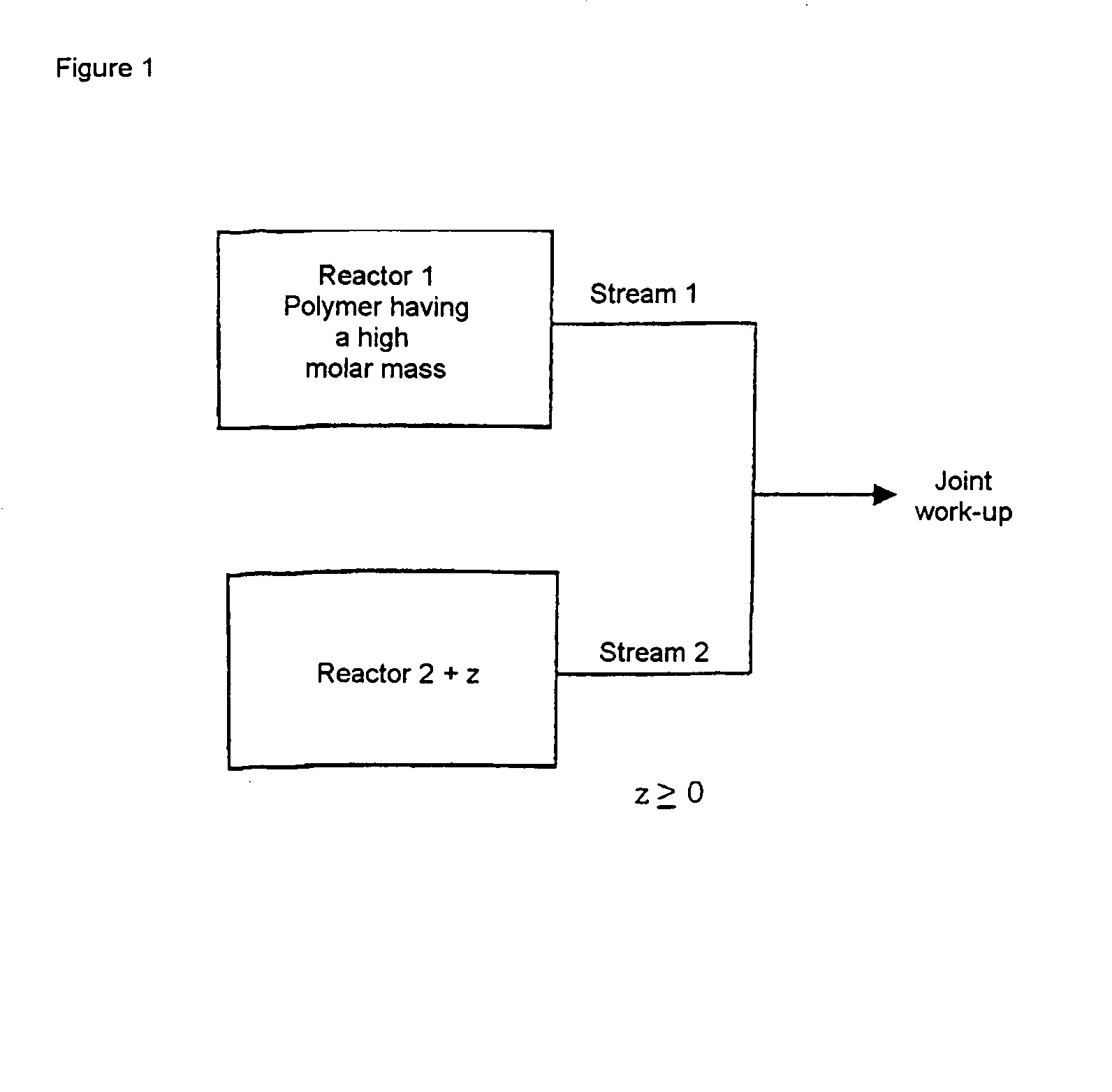Method of producing amorphous polyolefins with a wide mole weight distribution
a polyolefin and mole weight distribution technology, applied in the field of continuous process for producing mixtures of amorphous polyolefins, can solve the problem that polyolefins can only be processed with extreme difficulty in mel
- Summary
- Abstract
- Description
- Claims
- Application Information
AI Technical Summary
Benefits of technology
Problems solved by technology
Method used
Image
Examples
example 1
[0097]An ethylene-norbornene copolymer having a VN of 220 ml / g, a mass average molar mass of 280,000 g / mol and a glass transition temperature of 70° C. is prepared continuously as a 6% strength by weight solution in decalin using process variant 3. A 50% strength by weight solution of another ethylene-norbornene copolymer having a VN of 15 ml / g, a mass average molar mass of 12,000 g / mol and a glass transition temperature of 65° C. in decalin is then metered continuously into the first ethylene-norbornene copolymer solution in such an amount that the proportion of the higher molecular weight polymer is 8 percent by weight of the total mass of polymer. The solution is mixed well and the solvent is removed thermally using known techniques. A pressed plate of this product has a transparency of 93.3% and a haze of 2.5%. This demonstrates the high homogeneity of the mixture.
example 2
[0098]An ethylene-norbornene copolymer having a VN of 220 ml / g, a mass average molar mass of 280,000 g / mol and a glass transition temperature of 70° C. is prepared continuously as a 6% strength by weight solution in decalin using process variant 3. A melt of another ethylene-norbornene copolymer having a VN of 15 ml / g, a mass average molar mass of 12,000 g / mol and a glass transition temperature of 65° C. in Exxol is then metered continuously into the first ethylene-norbornene copolymer solution in such an amount that the proportion of the higher molecular weight polymer is 15 percent by weight of the total mass of polymer. The solution is mixed well and the solvent is removed thermally using known techniques. A pressed plate of this product has a high transparency and low light scattering, indications of good homogeneity. A pressed plate of this product has a transparency of 93.0% and a haze of 2.8%. This demonstrates the high homogeneity of the mixture.
example 3
[0099]An ethylene-norbornene copolymer having a VN of 130 ml / g, a mass average molar mass of 120,000 g / mol and a glass transition temperature of 85° C. is prepared continuously as a 20% strength by weight solution in decalin using process variant 3. A 50% strength by weight solution of another ethylene-norbornene copolymer having a VN of 15 ml / g, a mass average molar mass of 12,000 g / mol and a glass transition temperature of 65° C. in decalin is then metered continuously into the first ethylene-norbornene copolymer solution in such an amount that the proportion of the higher molecular weight polymer is 25 percent by weight of the total mass of polymer. The solution is mixed well and the solvent is removed thermally using known techniques. A pressed plate of this product has a transparency of 93.5% and a haze of 2.4%. This demonstrates the high homogeneity of the mixture.
PUM
| Property | Measurement | Unit |
|---|---|---|
| molar mass | aaaaa | aaaaa |
| molar mass | aaaaa | aaaaa |
| molar mass | aaaaa | aaaaa |
Abstract
Description
Claims
Application Information
 Login to View More
Login to View More - R&D
- Intellectual Property
- Life Sciences
- Materials
- Tech Scout
- Unparalleled Data Quality
- Higher Quality Content
- 60% Fewer Hallucinations
Browse by: Latest US Patents, China's latest patents, Technical Efficacy Thesaurus, Application Domain, Technology Topic, Popular Technical Reports.
© 2025 PatSnap. All rights reserved.Legal|Privacy policy|Modern Slavery Act Transparency Statement|Sitemap|About US| Contact US: help@patsnap.com



